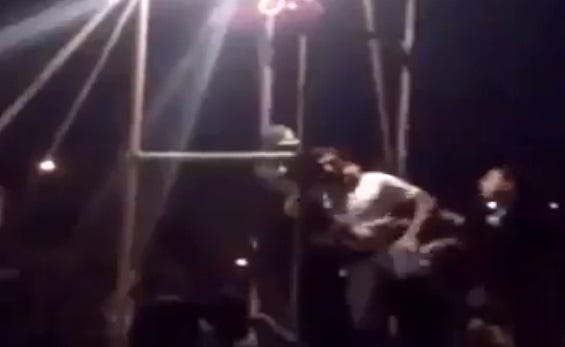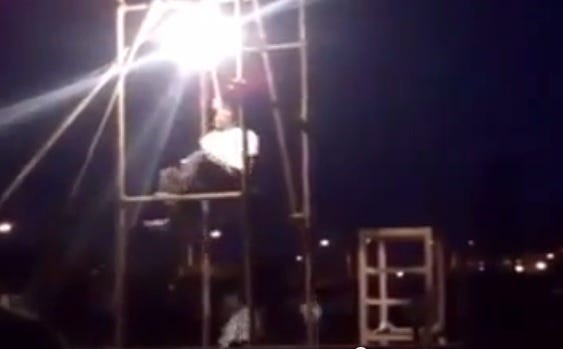Power Punishment & Execution in Iran : An analysis of Foucault’s Discipline and Punishment applied to modern Iran
Public Execution in a Soccer Stadium in Sabzevar City, in the Khorasan Province of Iran.
In his seminal work, Discipline and Punishment, the French philosopher Michel Foucault remarked on the political significance of public executions as they once stood in the West.
“The public execution is to be understood not only as a judicial but also as a political ritual. It belongs, even in minor cases, to the ceremonies by which power is manifested.” — (Foucault, page 47)
Though his focus is 18th century Europe, Foucault’s remarks have startling applicability to the current situation in Iran.
Iran leads the world in per capita executions, and is one of the few countries which continues to publicly hang condemned individuals, creating a spectacle of terror in the street. These executions carry political significance beyond the administration of supposed justice. They are in essence an abstraction of the political and judicial climate in Iran, in which a population is controlled through sheer violence and terror.
To illustrate my point, I will reference a shocking amateur video which emerged from Iran this week. The video appears to depict a prisoner who is set to be publicly hanged in Karaj on February 25th. At this time I do not have information as to the identity of the prisoner or the crime he was charged with.
VIDEO IS GRAPHIC AND DISTURBING
In the video the man is seen begging to receive a final embrace from his Mother who is in the crowd. It appears that his Mother was present and can also be heard yelling to her son.

In typical fashion, the regimes henchmen denied the man’s request, thereafter the man becomes defiant and resists his executioners. He wrestles away from his guards and kicks over a ladder which was to be used in his execution.
What is even more notable than the mans brave resistance, is the cheers from the crowd that rise when he kicks one of his guards, and breaks out of his handcuffs in an attempt to escape. The guards protecting the scene yell at the crowd to move back and to be quiet, though there is widespread cheers for the man’s escape attempt.

The man is finally beaten into submission by a gang of guards, and his battered body is hoisted up the ladder and the noose is put around his neck. Despite the savage beating that he received, the man’s spirit remains defiant as he resists, even
with the noose around his neck.

The scene is not only powerful but serves as a poignant example of Iran’s judicial system and repressive state power, using violence and terror in order to subdue a defiant population.
Foucault’s analysis of 18th century punishment from his work Discipline and Punishment, and the ritual of the public execution in particular, evoke eerie parallels with modern day Iran.
“ It is a ceremonial by which a momentarily injured sovereignty is reconstituted. It restores that sovereignty by manifesting it at its most spectacular. The public execution, however hasty and everyday, belongs to a whole series of great rituals in which power is eclipsed and restored… Its aim is not so much to re-establish a balance as to bring into play, as its extreme point, the dissymmetry between the subject who has dared to violate the law and the all-powerful sovereign who displays his strength.”(Foucault, page 48)
Through Foucault’s analysis we can understand the need which drives the regime to continue such a horrific spectacle, though it is faced with continual criticism by much of the civilized world. The regime needs the public execution as a ritual of state power and control against an increasingly discontented populace. The public execution is not meant to restore the balance of justice, but to display the “dissymmetry between the subject who has dared to violate the law and the all-powerful” regime.
Foucault also analyzes the role that the crowd plays in the execution, which provides an interesting explanation for why many Iranians choose to attend such a horrific spectacle.
“If the crowd gathered round the scaffold, it was not simply to witness the sufferings of the condemned man or to excite the anger of the executioner: it was also to hear an individual who had nothing more to lose curse the judges, the laws, the government and religion.” (Foucault, page 91)
In the video the tension from the crowd can be heard throughout the man’s pleading, and it finally erupts in restrained jubilation when he briefly escapes. For many Iranians who do attend such an event, it is to glimpse the momentary defiance of the condemned man, and use the opportunity to express their own frustration with the regime.
Near the end of the video a man can be seen in the crowd openly criticizing the regimes denial of the man’s final request. He is heard stating, “Regardless of his crime he should have been allowed to see his Mother.”

Though many Iranians may be quick to recall their history and their civilization which spans 2,000 years, it appears that the Iran of today is caught in a time warp in which 18th century justice reigns in the street.
For those of us who remain defiant in our opposition to this barbaric regime, we can find solace in the brave resistance of everyday Iranians, whether they are facing down the gallows, writing graffiti on the streets, or publishing blogs criticizing the regime.
These harsh realities should serve as a wake-up call that Iran is not undergoing a new era of moderation, but has actually increased the rate of executions since the election of Rouhani.
“There were some encouraging signs last year where political prisoners were released … But it appears at least in the past seven weeks that in fact executions have been scaled up,” U.N. human rights spokeswoman Ravina Shamdasani said in a news briefing.
In 2013, the Iranian regime executed 624 individuals according to the Iran Human Rights Documentation Center. It has used execution a tactic of terror, particularly against political prisoners since the 1980s.
The public execution of this man serves to absolve him of his guilt, regardless of his crimes, as his humanity is affirmed through his resistance to this barbaric ritual. His resistance validates his own humanism and the humanity in all Iranians who resist in the face of death and despair. The dehumanizing actions of the regime serve to destroy any legitimacy or humanity that the sovereign, or in this case Khamenei, claims to possess.
Our resistance is what makes us civilized, and though the regime attempts various forms of torture, terror, and repression to dehumanize us, our resistance serves to vindicate our humanity and civility in the face of the barbarism of this regime.
Hamid Yazdan Panah
